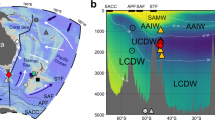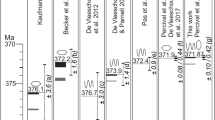Abstract
One of the most important projects envisaged ever since the possibility emerged of making tandem accelerator mass-spectrometric radiocarbon determinations has been that of investigating changes in the radiocarbon age of the deep ocean1. Initial attempts to achieve this2 were thwarted by difficulties imposed by bioturbation, because these workers used core V28–238 with an accumulation rate of only ∼1.5 cm kyr−1, thus emphasizing the need to work in a core with a higher accumulation rate. Working in the glacial section of core TR163–31B with an accumulation of 10 cm kyr−1, we show here that the ventilation age of Pacific deep water was about 500 years greater in last glacial times than it is today.
This is a preview of subscription content, access via your institution
Access options
Subscribe to this journal
Receive 51 print issues and online access
$199.00 per year
only $3.90 per issue
Buy this article
- Purchase on Springer Link
- Instant access to full article PDF
Prices may be subject to local taxes which are calculated during checkout
Similar content being viewed by others
References
Broecker, W. S., Mix, A., Andree, M. & Oeschger, H. Nucl. Instrum. Meth. Phys. Res. B5, 331–339 (1984).
Andree, M. et al. Geophys. Monogr. 32, 143–153 (1985).
Ninkovich, C. D. & Shackleton, N. J. Earth planet. Sci. Lett. 27, 20–34 (1975).
Peng, T.-H. & Broecker, W. S. Nucl. Instrum. Meth. Phys. Res. B5, 346–352 (1984).
Bard, E., Arnold, M., Duprat, J., Moyes, J. & Duplessy, J.-C. Clim. Dynamics 1, 101–112 (1987).
Berger, W. H., Killingley, J. S. & Vincent, E. Oceanologica Acta 1, 203–261 (1978).
Shackleton, N. J., Hall, M. A. & Boersma, A. Init. Rep. DSDP 74, 599–612 (1984).
Arnold, M., Bard, E., Maurice, P. & Duplessy, J.-C. Nucl. Instrum. Meth. Phys. Res. B29, 120–123 (1987).
Shackleton, N. J., Hall, M. A., Line, J. & Cang, S. Nature 306, 319–322 (1983).
Druffel, E. M. Geophys. Res. Lett. 8, 59–62 (1981).
Ostlund, H. G. & Stuiver, M. Radiocarbon 22, 25–53 (1980).
Broecker, W. S. et al. Paleoceanography (in the press).
Damon, P. E. in Nuclear and Chemical Dating Techniques, ACS Symp. Ser. (ed. Curry, L. A.) 233–244 (Am. Chem. Soc., Washington, DC, 1982).
Andree, M. et al. Clim. Dynamics. 1, 53–62 (1986).
Broecker, W. S. & Peng, T.-L. Tracers in the Sea 236–274 (Eldigio, New York, 1982).
Pedersen, T. F. Geology 11, 16–19 (1983).
Author information
Authors and Affiliations
Rights and permissions
About this article
Cite this article
Shackleton, N., Duplessy, JC., Arnold, M. et al. Radiocarbon age of last glacial Pacific deep water. Nature 335, 708–711 (1988). https://doi.org/10.1038/335708a0
Received:
Accepted:
Issue Date:
DOI: https://doi.org/10.1038/335708a0
This article is cited by
-
Coupling of oceanic carbon and nitrogen facilitates spatially resolved quantitative reconstruction of nitrate inventories
Nature Communications (2018)
-
Increased reservoir ages and poorly ventilated deep waters inferred in the glacial Eastern Equatorial Pacific
Nature Communications (2015)
-
Carbon dioxide release from the North Pacific abyss during the last deglaciation
Nature (2007)
-
Old radiocarbon ages in the southwest Pacific Ocean during the last glacial period and deglaciation
Nature (2000)
-
High concentration of atmospheric 14C during the Younger Dryas cold episode
Nature (1995)
Comments
By submitting a comment you agree to abide by our Terms and Community Guidelines. If you find something abusive or that does not comply with our terms or guidelines please flag it as inappropriate.



